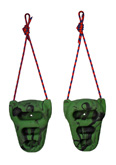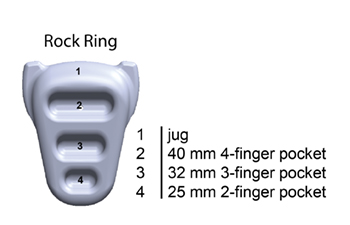Rock Rings are designed to provide a convenient, portable, compact and inexpensive approach to climbing-specific training. Their single point suspension allows them to move freely, relieving the stress to your joints and there by preventing injury.
The 10-Minute Sequence consists of ten tasks, one performed at the start of each minute, with the remaining time used to rest until the start of the next minute. It is an excellent format for training both strength and stamina in the same workout, for improving your recovery, or just for warming up. It is also a great way to simulate the demands of your current project. Be creative and don't limit yourself. It could be five minutes or thirty minutes; you could do it in 45-second cycles or two-minute cycles. Experiment with your training and keep it as varied as possible.

If you have never trained before, it will take six to eight weeks to become accustomed to the training routine. It may take four weeks to make it through the whole routine, that's okay, (over zealous training may lead to injury) take it at your own pace. The key to training is to set your schedule and follow it religiously. If there are certain holds or moves that cause you pain, avoid them. The skin on your fingers will get sore and may take a few weeks to callous up - but then you will be ready to really train hard. You should be able to go through the whole routine with ease before you move up to a more difficult sequence.
Installing / Mounting The Rings
Don't underestimate the effect that location will have on the success of your training program. It is a lot easier to spend time in a warm, well-lit room than a freezing garage or dank basement. The portability and convenience of the Rock Rings can be a big advantage here. It is tough enough for most of us to stick to a training program even under the best of conditions, so give yourself every advantage: warmth, light, music, or whatever it takes for you to create a positive training environment.
Rock Rings can be suspended from any solid anchor point, a pull-up bar, tree limb, eye-hooks in an exposed beam or framing member, etc. Ideally, the rings should hang near the height of your full extension, but anyplace with enough height to get your feet off the ground and adequate headroom will suffice. Make sure that the anchor points you choose can withstand the loads you will be placing on them, and that they can't slide or move while the rings are in use. It is easy to underestimate the force you will be able to generate, so be conservative and consult an engineer if you are in doubt.
Principles
Rock Rings are most effective at training contact strength and body tension. Contact strength, also referred to as finger strength, is simply the ability to hold onto the holds (as opposed to the ability to move between the holds). It is the single most important type of strength for a climber to have. If you can't even hold onto the grips, there is no way you will be able to move between them. Body tension, sometimes called core strength, allows you to distribute the force you are generating between your points of contact and to direct your movement. It allows you to weight your feet and save energy. This type of strength (or lack thereof) is especially noticeable in controlling swings around the lips of roofs or on steep rock in general, but it is critical to all climbing movement.
Body Position Key:
Look at the hold layout to see which hold/s you will be using at each minute interval. Also check the body position key to see which position you will be assuming at the given time interval. We have found these sequences to be quite effective, and depending on how you put them together, the ten minute sequence can provide a good combination of endurance and power. Please remember these are only general guidelines, and sample routines, the specifics of training yourself we leave up to you.

Exercises
Dead Hang: This is the fundamental exercise for developing contact strength. You should master the dead hang on any particular hold before attempting any other exercise on that hold. Never lock you elbows completely. Always keep a slight bend to prevent injury.
Bent Arm Hang: A variation of the dead hang which will begin to develop your ability to pull through and lock-off. This can be done at any angle, and should be varied as much as possible. Pull yourself up to the designated angle and hold a static contraction for the designated amount of time. Be careful of doing maximal contractions at full lock-off, as they can be as injurious as fully locked-out elbows.
Offset Hangs: Begin as with the bent arm hang. Shift your weight all the way to one side and hold a contraction. Shift your weight laterally, all the way to the other side, without lowering your body and hold an equal contraction. Repeat. Vary the angle of your lock-off, the duration of your lock-off, and the number of repetitions.
Pull-ups: Try to be as smooth as possible. Don't jerk, kip, swing, or otherwise cheat. Keep your lower body quiet. Don't lock your elbows completely at the bottom. Focus on maintaining perfect form, and don't worry about the number of repetitions.
Offset Pull-ups: The first step to one-arm pull-ups. Position yourself with your weight centered under one arm, as if to do a one-arm pull-up. Choose a lower hold with the other hand and give yourself just enough assistance to complete the exercise.
One-arm Pull-ups: Now you really have some power! Follow the same guidelines as for pull-ups but pronate your arm more. If you're getting close, but can't quite do one-arms, do an offset pull-up, but perform the negative contraction (lower yourself) as a pure one-arm. The potential for injury is very high, so it is absolutely critical to be smooth. Don't bounce!
L-Hang:The emphasis here is on core strength. Choose a hold that you're fairly comfortable on. You can dead hang or bent arm hang. Pull your legs up from the hips, keeping your knees straight and your toes pointed. Hold a static contraction with your legs at 90 degrees to your torso or do slow repetitions raising your legs as far as you can but only lowering to about 45 below horizontal. If you lower you legs all the way, it will take the tension off your abs and constitute a rest. The idea is to keep your abdominal muscles contracted the entire time. If straight leg raises are too difficult, bend your knees at a 90 degree angle.
Front Lever: Work up to these by performing them first with both legs bent at the knees, and then with one leg straight and one bent. If you can do a good front lever, try it with one arm.
Warning All Rock Ring Users: Training on Rock Rings carries risk of injury to fingers, arms, shoulders and the joints connecting them. Take every precaution to avoid damage to yourself; warm-up, stretch, don't overtrain and listen to your body. Remember, even under the best of circumstances, injuries can occur. In addition, however you mount your rock rings, be sure it is to a solid structure. There should be no possible way for the Rock Rings to come down while training.

| Time (minutes) | Task | Hold |
| 1st minute | 3 pull-ups | Jugs |
| 2nd minute | 10 seconds bent-arm hang 15 seconds Dead Hang |
3 Finger Pockets 2 Finger Pockets |
| 3rd minute | 2 Offset Pull-ups 2 Offset Pull-ups other way |
4 Finger Edge & 2 Finger Pocket (same holds) |
| 4th minute | 20 seconds L-Hang 10 seconds Dead Hang |
4 Finger Edges 3 Finger Pockets |
| 5th minute | 5 Pull-ups | 4 Finger Edges |
| 6th minute | 20 seconds Bent Arm Hang 10 seconds Dead Hang |
3 Finger Pockets 2 Finger Pockets |
| 7th minute | 15 seconds L-Hang 15 seconds Dead Hang |
4 Finger Edges 4 Finger Edges |
| 8th minute | 10 seconds Offset Hang 10 seconds Offset Hang (other way) |
4 Finger Edges & 2 Finger Pockets (same holds) |
| 9th minute | 20 seconds L-Hang | 4 Finger Edges |
| 10th minute | 5 Pull-ups Dead Hang to failure |
3 Finger Pockets 3 Finger Pockets |
2025 Metolius Climbing